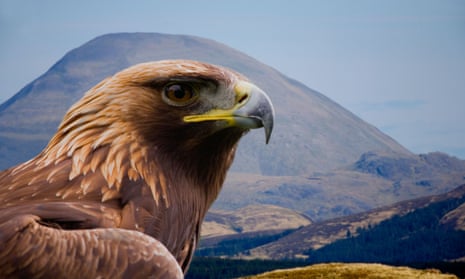Conservationists hope golden eagles will start reappearing over northern England and the Lake District as part of a project to release up to 10 eagles in southern Scotland.
The birds will start to be released at a secret location south of Edinburgh from next year in a £1.5m programme by conservationists and landowners to restore golden eagle numbers in the southern uplands, where they have struggled to survive.
The young eagles are expected to fly over the English border in search of food and new territories as they are released in the Moffat hills each autumn over the next five years.
Golden eagles are practically extinct in northern England after decades of persecution by gamekeepers, the spread of commercial conifer forests and inadequate food supplies, and there are none in Wales.
Although the Cumbrian Fells, north Pennines and the moors of Northumberland could be suitable territories, there was until recently only one golden eagle in the Lake District, an elderly male whose mate died in 2004. It was not spotted at its Haweswater nest last year and is assumed to be dead.
While their numbers are slowly increasing in the Highlands, where about 500 pairs now breed, experts say golden eagle numbers in southern Scotland are far lower than they should be owing to persecution and loss of habitat.
There are just two to four breeding pairs in the region, which ought to support 10 to 16 pairs as well as single birds. If the region’s golden eagle population is sustained by the released birds or expands, they could eventually try to repopulate northern England.
The birds naturally roam over large areas: a golden eagle released in Ireland has settled in Argyll, west of Glasgow. Ornithologists believe the very heavily urbanised central belt of Scotland prevents them from spreading south from the Highlands.
More than £158,000 in European Union funding for the south of Scotland golden eagles project was announced by Roseanna Cunningham, the Scottish environment secretary, on Tuesday morning. It already has £1.3m from the Heritage Lottery Fund, and is supported by the Duke of Buccleuch’s estates in southern Scotland, Scottish Natural Heritage, the conservation agency, and Scottish Land and Estates, a landowners’ body.
It will involve putting satellite tags on all the released birds. These will allow ornithologists to track the eagles and monitor their behaviour. The devices also allow them to detect whether the birds have disappeared if the tags suddenly go offline.
A detailed scientific study of 131 tagged golden eagles in the Highlands over a 12-year period found a third went missing in unexplained circumstances, or were found dead, on or near grouse moors.
Wildlife crime experts at the Royal Society for the Protection of Birds (RSPB), a partner in the project, say many birds of prey are struggling to survive in northern England because of systematic poisoning, shooting and nest disturbance by gamekeepers to protect commercial red grouse and pheasant shoots.
Scottish conservationists have been in dialogue with grouse moor managers and landowners in northern England to build up support from the country sports industry for the reintroduction programme and cut down on illegal persecution to protect grouse moors.
Although naturalists estimate England could support 300 pairs of hen harriers, only three pairs bred young this year and none did so on a grouse moor. Peregrine falcons are virtually absent around grouse moors, said Guy Shorrock, a wildlife crime investigator with the RSPB.
A small population of red kites in Gateshead on the Tyne is failing to spread into nearby moors, their natural habitat, even though red kites are thriving in the Chilterns and around London.
“Whilst we can’t say all estates are involved in this, the reality is that we are concerned if golden eagles start coming south and start hanging around grouse moors,” Shorrock said. “[Birds of prey] should be in the countryside, but the reality is that if we release them in certain areas, they do very badly.”
Amanda Anderson, thedirector of the Moorland Association, a conservation body linked to the shooting industry, said it supported the project, as did many others in the industry.
“There are many organisations, land managers and gamekeepers in the north of England who are committed to species conservation and eradicating wildlife crime, which continues to decline, and it is premature to make predictions about birds that will not be released for some time,” she said.









